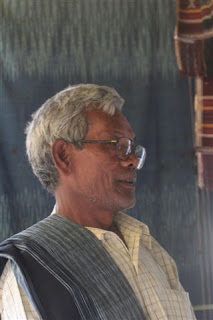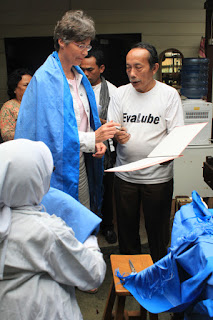Muara is a bay in the southwest corner of Lake Toba. The long descent by road is spectacular. Hairpin curves open onto breathtaking views. The sign reads, Muara na Uli, Beautiful Muara. Muara has been posted as a new tourist destination. It used to be a rather out-of-the-way place, approached best by boat, with not much to offer to tourists who like a little bit of comfort. But now a new future lies clearly before it.
Today, exactly a month ago, I visited Muara. Restuala Namora Pakpahan had told me that there would be a weaving workshop on 23 November based on my book. This reaction to my book exceeded my wildest dreams but fit with my secret hopes and longings. I knew that I had to be present.
We arrived in Muara on the evening of the 22nd and the next morning made our way over to Huta na Godang, the village where all the weavers in the frontispiece of Legacy in cloth live and where Pak Restuala has his home. I had no inkling of what was about to transpire, but I had been unable to sleep the night before. When Pak Jerry pulled up and I looked out of our vehicle, I was suddenly overwhelmed by a sense of something enormous about to happen. Scaffolding had been built around the yard to the right and in the road I saw a person walking with a Batak textile over his shoulder. This only happens when there is a bona fide ceremony.
It was Pak Restuala. He greeted us warmly and showed me the red-painted sign hanging at the gateway to his yard announcing a (in translation) Weaving Workshop of Batak Ulos with Sandra Niessen. Elegantly-dressed dancers bade us enter the textile-clad space.
 |
Muara textiles were hung on the scaffolding surrounding the yard
where the "workshop" took place on 23 November 2010. |
First Pak Restuala’s mother wrapped a beautiful
harungguan textile around my shoulders, the most prestigious cloth woven in the region.
 |
One of only three remaining Muara weavers who know how to make the
harungguan textile, the kind that was wrapped around my shoulders on that
unforgettable day. |
Then I was greeted by a long line-up of friends. They included Ompu Ester and Ompu Josua and their husbands, to whom I had given copies of
Legacy four months prior. I cannot ever remember having received a warmer welcome and I was ushered over to the seat of honour next to Pak Restuala. I found myself amid dozens of women working at all different aspects of textile production from winding the warp to twining the decorative edging on the finished cloth.
 |
| Women were executing every aspect of weaving. |
Their husbands were there, too, most of them sitting on chairs.
 |
| Ompu Josua doli, who later presented a speech to me. |
Pak Restuala began to speak. He told me that he had seen me when he was a small schoolboy, when I had come to Muara the first time in 1980. Now a grown man of 35 years old, with vast and varied life experience, including a career in Jakarta, he had returned to Beautiful Muara. He wanted to be one of the architects of change for a better future. He is particularly interested in perpetuating Batak culture so that it may survive undiminished in the world of the future. When he saw my book, he decided that he wanted to begin with Batak
ulos, the cloth that is indispensable at all stages of Batak life. Essentially I was being pressed, ever so gently but just as unmistakably, into serving as an ambassador of Muara and Batak culture.
And my arrival on the 23rd was a catalyst to kick-start the revival of weaving in Muara. I remembered the brief and sincere discussion with Ompu Ester before I left in June, when she asked me to assist in reviving weaving in Muara and had told me that it was not possible to produce indigo dye anymore. Now, before my eyes, there were indigo pots containing indigo.
Alot had changed in four months. I imagined the long discussions, the will, the synergy, the vision, the energy, the co-operation needed to bring this special day together. And now I saw the joy and the spirit of the villagers.
 |
| Ompu Josua is sitting to the left and I am handing her photographs. As always, she has a smile on her face. Pak Restuala is sitting to the right holding a copy of my book. In the foreground, just barely visible, is the wooden dish (sapa) with corn and peanuts. I have that beautiful harungguan textile wrapped around me, but it is slipping off my shoulder. |
I had one additional copy of
Legacy with me and I gave it to Pak Restuala while I expressed my amazement at the number of different kinds of Batak textiles lining our ceremonial space, the skill of the weavers in making such cloths and the ancientness of the tradition, all this by way of emphasizing why this art form must not be lost. I then introduced MJA Nashir as he has already done so much to document (in written, photographic and filmic form) our travels, work that will one day be even more accessible to the Batak than my own. I did not want him to disappear into anonymity on this occasion. Later, he too was
diulosi, wrapped in a Batak textile, again by Pak Restuala’s mother.
 |
MJA Nashir receiving an ulos from
Pak Restuala's mother. |
 |
MJA Nashir's happy receipt of the ulos.
|
Then it was breakfast time and a huge, ancient wooden plate, the kind used by the Batak a century ago, was placed before us laden with boiled corn and local fruits. Ensuring the perpetuation of Batak indigenous culture was his goal, Pak Restuala emphasized again, as we all nibbled on corn and I gave away some photographs that MJA Nashir had taken when we came in June.
Our attention then turned to music, another threatened aspect of Batak culture.There was a youthful band directed by a very energetic music-lover, and they played tune after tune. Our visit was also giving them occasion to play in public. Their talent was admirable.
 |
| The youthful musicians of Muara. |
The mood was warming up. We danced, posed for group photographs, toured all of the different weaving techniques and reviewed the hanging textiles.
 |
The school teacher is to the left.
Pak Restuala is in the middle. |
The delicious lunch in the home of a school-teacher was an example of the best cuisine that indigenous Batak culture has to offer. I was deeply impressed by the initiative to present indigenous culture in so many of its aspects and by the way the challenge had been met.
But I have been slow to put pen to paper to write this blog. I have felt far too overwhelmed by the energy of the people of Huta na Godang: the trust, the caring, the hope, the expectations. When I sat there listening to Pak Restuala’s words, I scarcely knew how to accommodate the lot that life was dealing me. The best in life is not always what we choose. Sometimes, we are chosen by life. Muara now feels like my Batak home and I am tied to it forever, just as the women of Huta na Godang in Muara will always grace the front of my book.

 |
A last hug from the
indigo dyer.
|
 |
At the end of the day. |
Muara, O Muara.
(All photographs in this post, except those of himself, are by MJA Nashir)





